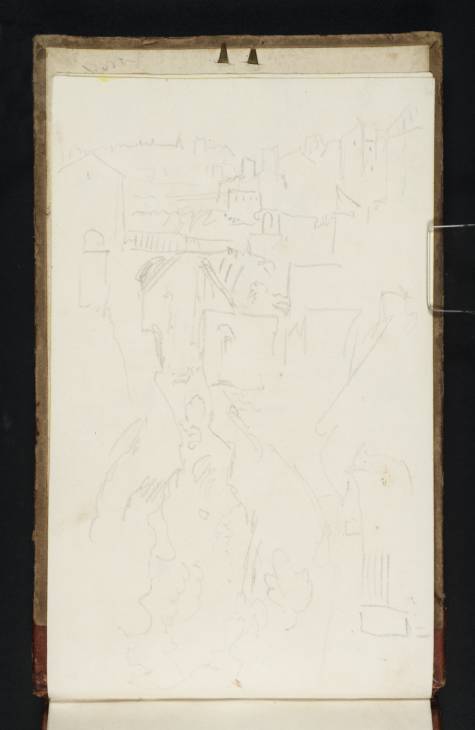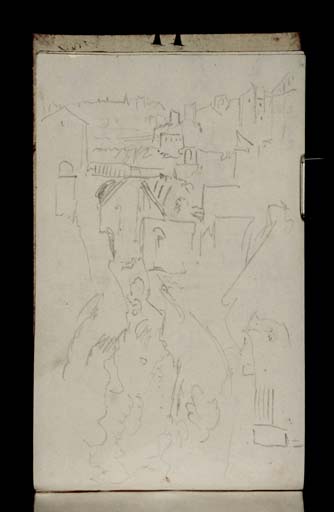Joseph Mallord William Turner Ponte San Rocco and the Grand Cascade, Tivoli 1819
Image 1 of 2
Joseph Mallord William Turner,
Ponte San Rocco and the Grand Cascade, Tivoli
1819
Joseph Mallord William Turner 1775–1851
Folio 2 Verso:
Ponte San Rocco and the Grand Cascade, Tivoli 1819
D14936
Turner Bequest CLXXIX 2 a
Turner Bequest CLXXIX 2 a
Pencil on white wove paper, 186 x 112 mm
Accepted by the nation as part of the Turner Bequest 1856
References
1909
A.J. Finberg, A Complete Inventory of the Drawings of the Turner Bequest, London 1909, vol.I, p.526 as ‘Waterfall (?), with wooden bridge, Tivoli’.
This sketch of Tivoli depicts the view looking south from beneath the so-called Temple of Vesta towards the ‘Grand Cascade’, the former falling point of the River Aniene. Spanning the gully in the centre of the composition is a wooden bridge which was erected upon the foundations of a previous stone bridge, the Ponte San Rocco, which had been swept away in a flood in 1808. Turner has used the full length of the sketchbook page to capture the dramatic height of the gorge and the plunging cascading water. Further sketches can be seen on folios 3 and 89 verso (D14937 and D15096; Turner Bequest CLXXIX 88a), and another more detailed drawing can be found in the Tivoli sketchbook (Tate D15494; Turner Bequest CLXXXIII 27). Turner also recorded the view looking towards the bridge from the opposite direction, see folios 43 and 77 verso (D15006 and D15072).
The picturesque properties of this prospect had made it a popular subject for artists, and by the early nineteenth century it was a well-established topographical motif. An early example is Gaspar van Wittel’s (1652/3–1736), View of Tivoli circa 1700 (Walters Art Gallery, Baltimore), which pictures an artist sketching the view from a point below the Temple of Vesta.1 Similar vistas incorporating the original stone Ponte San Rocco include a drawing and related print by Albert Christophe Dies (1755–1822) published in Vues Pittoresques de l’Italie (circa 1795),2 François-Marius Granet (1775–1849), Ponte San Rocco and Falls, Tivoli circa 1810–20 (Metropolitan Museum of Art, New York) and Revd William Henry Barnard (1767/9–1818), Tivoli (Tate, T09427). Contemporaneous views, meanwhile, depicting the temporary wooden bridge, include an illustrations in Italian Scenery from drawings made in 1817 by Miss Batty (published 1820),3 and in a drawing by James Hakewill (1778–1843), Tivoli 1817 (British School at Rome Library).4
It is no longer possible to find the same vantage point in present-day Tivoli. A devastating flood in 1826 persuaded Pope Gregory XVI to divert the course of the river away from the residential district. Consequently, the town’s many waterfalls, including the Grand Cascade near to the temples of the Acropolis, were replaced instead by the great waterfall in the Villa Gregoriana to the north-east of the town. Furthermore, the topography of the town was much changed and the wooden Ponte San Rocco was succeeded by the newly built Ponte Gregoriano.
Nicola Moorby
December 2009
The drawing is reproduced in colour in Raymond Keaveney, Views of Rome from the Thomas Ashby Collection in the Vatican Library, exhibition catalogue, Smithsonian Institution, Washington 1988, no.71, p.[257].
[Elizabeth Frances] Batty, Italian Scenery from Drawings Made in 1817 by Miss Batty, London 1820, opposite p.115.
How to cite
Nicola Moorby, ‘Ponte San Rocco and the Grand Cascade, Tivoli 1819 by Joseph Mallord William Turner’, catalogue entry, December 2009, in David Blayney Brown (ed.), J.M.W. Turner: Sketchbooks, Drawings and Watercolours, Tate Research Publication, December 2012, https://www


